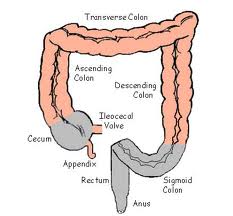Ileocecal valve
The ileocecal valve (Lat. valva ileocaecalis ) is a functional seal between the colon and small intestine. It bulges in the right lower abdomen as invagination of the last portion of the ileum ( " ileum " ) in the colon before. Under the Basel anatomist Caspar ileocecal (1560-1624) it is also referred to as the ileocecal valve or flap Bauhinsche.
Design and function
Originally differed in each case an upper ( superior labrum or ileocolicum ) and lower lip ( labrum ileocaecale or inferior ). Endoscopic studies have shown that the ileocecal valve in the living human is round and has no lips. The lips are an artifact that arises only by the death of man.
The ileocecal valve is used as a functional seal between the large and small intestine and is usually only in the direction of colon consistently by preventing valve-like in elongation of the intestine that intestinal content - and with this bacteria - may penetrate the clear germ poorer end of the ileum.
The ileocecal valve located below the protuberance of the large intestine is called the cecum ( cecum ) and carries at its lower pole of the vermiform appendix ( vermiform appendix ).
Diseases
Limited to the colon flap diseases as such there is not. However, inflammation of the small intestine, large intestine and cecum can spill over to the ileocecal valve and lead to a so-called Bauhinitis, for example, Crohn's disease, ulcerative colitis or Ileozäkal tuberculosis. A Miserere can be the result. Also, large gallstones can catch there on the way to the colon and cause a gallstone. In the digestive tract occurring tumors, such as neuroendocrine carcinoma ( carcinoid ), can of course also manifest. A defect of the flap may be the cause of a small bowel overgrowth.










